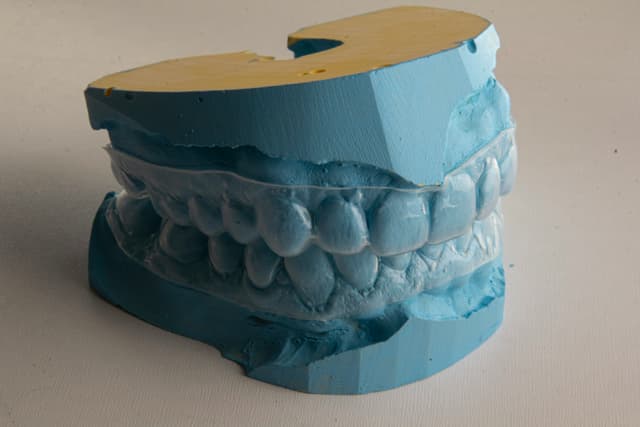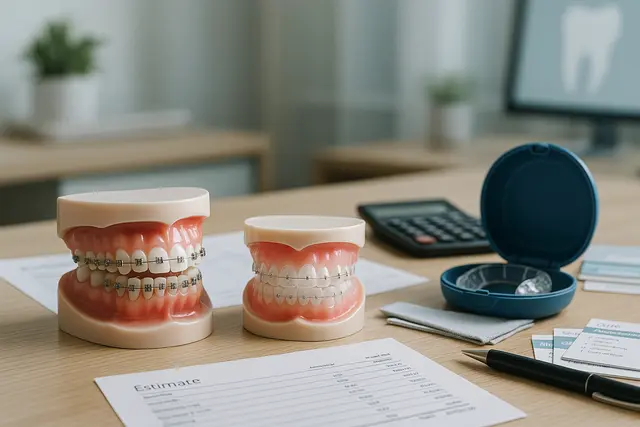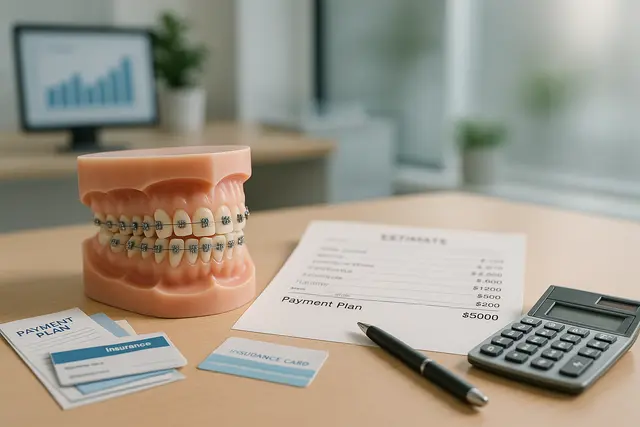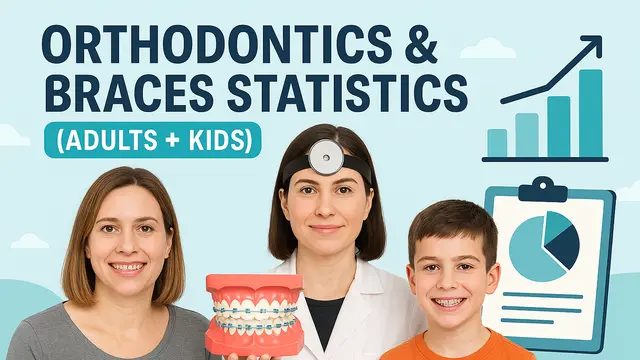Orthodontics
9 min read
Feb 09, 2025
How to Choose Between Invisalign and Traditional Braces
Straightening your teeth is a significant decision that impacts your oral health, appearance, and confidence. Invisalign and traditional braces are two of the most common orthodontic options available today.

What Are Traditional Braces and How Do They Work?
If you picture braces and immediately see shiny railroad tracks, you are thinking of traditional braces, those dependable metal brackets and wires that have straightened smiles for generations. Traditional braces consist of metal fixtures bonded to each tooth, linked by wires of traditional braces that your orthodontist tightens to guide movement.
They are a universal treatment that can fix crowding, large gaps, or complex bite issues because the brackets of traditional braces give the doctor pinpoint control. Traditional braces are fixed in place, so there is no forgetting to pop them in after lunch, but that also means you have to ensure the braces stay intact by skipping taffy and caramel that could damage the braces.
Comparing Invisalign to Traditional Braces at a Glance
Before diving into every detail, you probably want the quick headline: invisalign vs the classic metal approach is mostly about visibility and lifestyle. Invisalign aligners are made from near‑invisible plastic, so casual observers rarely notice them. By contrast, the appearance of metal braces is obvious, though modern colored bands let teens treat their teeth like tiny canvases.
If you love selfies, the clear trays can feel like an instant win, yet some folks enjoy showing off their brace bling. Either way, the first round of evaluating aligners vs braces is purely cosmetic.
How Invisalign and Traditional Braces Differ in Function and Feel
Now let’s compare invisalign and traditional braces feature by feature. Both fall under orthodontic treatment designed to realign teeth, but their mechanics differ. Traditional metal brackets and wires exert continuous pressure, while clear trays apply force when you wear invisalign for the recommended twenty‑two hours a day.
Invisalign patients require discipline; removing trays to snack and forgetting to reinsert them stalls progress. Braces typically stay on until your treatment plan ends, so compliance is automatic. Choosing between invisalign and traditional systems should account for your daily routine, snacking habits, and memory for tiny plastic things.
What to Expect from Braces vs Clear Aligners
Marketing for every new gadget seems to shout “It’s the future!” but when you stack clear aligners vs braces, traditional metal still wins for certain bite corrections. Severe rotations, extreme crowding, or cases needing vertical tooth movement often respond faster to brackets and wires of traditional design. Your orthodontist will explain whether aligners over braces would get the same result or if metal power is required.
Side-by-Side Look at Invisalign vs Braces
While invisalign vs braces sounds like a duel, many practices offer both because they solve different problems. Braces can be used on any age and almost any case. Invisalign is a modern orthodontic marvel, but invisalign may not be suitable for teeth that need major vertical shifts. Still, for mild-to‑moderate alignment, treatment time can be similar, and braces are less noticeable than they were a decade ago if you pick ceramic braces or lingual braces that hide behind the teeth.
What Does Invisalign Treatment Involve?
Invisalign treatment involves an initial digital scan, 3‑D planning software, and a series of trays. The treatment option feels high‑tech and lets you preview your future grin on screen. Each set moves teeth a fraction before you swap for the next. Treatment time varies, yet many adults finish in roughly a year. Whether you choose invisalign or braces, you will still need retainers afterward, your jawbone is stubborn and loves to drift back to old habits.
Dental Hygiene with Braces vs Aligners
Day‑to‑day dental hygiene with traditional braces takes patience. Food loves to camp between brackets, so you must brush and floss carefully, perhaps adding water flossers for backup. Hygiene with traditional braces might sound tedious, but it prevents cavities around the brackets. Clear trays make mealtime easier because you pop them out, yet you must brush and floss before reinstalling to keep sugar from fermenting beneath plastic. Either route, your dental checkups continue every six months, and your dentist will praise whichever method keeps plaque at bay.
Lifestyle Differences Between Braces and Invisalign
Let’s talk lifestyle. Braces and invisalign both limit certain snacks. Braces to help protect wires bar you from popcorn and hard nuts that could snap components. Aligners and braces each dislike sugary sodas, but invisalign patients can enjoy those treats if they remove trays first, just remember to rinse well. Braces can make playing reed instruments tricky at first, although wax cushions lips quickly. Sports require mouthguards no matter which appliance you wear, so plan ahead.
Weighing the Pros and Cons of Both Options
Every decision benefits from a pros and cons list. Traditional braces are highly effective, never misplaced, and often cheaper. Cons of traditional braces include the appearance of traditional braces, occasional poking wires, and dietary rules. Invisalign benefits of invisalign feature stealth trays, simple cleaning, and fewer emergency visits for broken hardware.
Pros and cons of invisalign also include the responsibility of near‑constant wear and possible speech lisp the first week. Deciding between invisalign comes down to which drawbacks feel minor to you.
How Much Do Braces and Invisalign Cost?
Money talks, so let’s crunch numbers. The average cost of braces ranges widely by region, but traditional metal braces typically require less upfront cash than Invisalign. Clear ceramic brackets raise fees, and lingual braces are more expensive than traditional braces because of lab work. The cost of invisalign often matches high‑end ceramic braces.
Braces and invisalign aligners cost more if you need longer treatment time, extra refinement trays, or mid‑course wire changes. Ask your provider for a customized estimate and flexible payment plans.
Should You Choose Invisalign or Traditional Braces for Your Child?
Parents of teens often ask, “Is invisalign the right gadget or do we stick with brackets?” Compare invisalign and traditional braces against your child’s track record of keeping AirPods from vanishing. Traditional braces may be a better safety net for forgetful kids because the appliance stays put. Aligners are less likely to break, but losing one tray can set progress back a week. Traditional braces to determine total cost and discipline needs remains the gold standard for many families.
Is Invisalign More Comfortable Than Traditional Braces?
Beyond looks, the pros and cons of invisalign revolve around comfort. Smooth plastic means traditional braces can cause discomfort from rubbing metal; wax and silicone guards usually solve it, but trays start smooth from day one. Invisalign may still create pressure on certain teeth, though over‑the‑counter pain relief handles it. On the downside, invisalign patients require tray cleaning plus midday bathroom runs to brush after coffee.
How Braces Work to Shift Your Teeth Over Time
Ever wonder how braces use steady pressure? The wires of traditional braces act like a spring that tries to return to its original shape, tugging teeth along. Your orthodontist swaps wires to heavier gauges as you progress. Those adjustments explain why braces require regular visits every four to eight weeks.
Pros and Cons of Traditional Braces to Consider
Pros and cons of braces stack up as follows: braces are effective for almost every alignment woe, and braces are often recommended for complex jaw cases. However, braces can take a little longer for simple crowding, and braces typically require a longer de‑bracketing appointment to remove adhesive.
Traditional Braces vs Invisalign: Which Is More Effective?
Some folks instinctively think braces vs anything means old school loses. Yet traditional metal outperforms aligners in certain heavy‑lifting moves. Braces may be more effective at rotating cylindrical teeth or closing wide extraction gaps. In other words, brackets still earn their place.
Comparing Office Visits and Maintenance Needs
Put side by side, braces vs invisalign reveals a surprising tie in total office time. Aligners trade frequent wire tweaks for occasional tray pick‑ups. Braces are made of stainless steel and rarely crack, while aligners can warp in hot cars. Both appliances need diligent retainer wear afterward, or teeth, like toddlers, will wander.
Why Braces Might Still Be the Best Option for You
One overlooked advantage of braces is predictability. Traditional metal brackets and wires have been studied for decades, so your orthodontist can forecast each movement. Braces can be used even when patients grind their teeth at night, and braces may even help redistribute bite forces to reduce wear.
What to Know About the Costs of Aligners and Braces
Sticker shock often fades once patients divide the total by months of confidence gained. Aligners and braces to help calculate true value include add‑ons such as whitening or bonded retainers. Braces to help you make a budget should include retainer replacements down the road. Insurance may cover part of either appliance, so bring your benefit booklet to the consultation.
How Treatment Plans and Timelines Differ
Whichever treatment option you pick, your orthodontist drafts a treatment plan that maps every shift ahead of time. Traditional braces typically require eighteen to twenty‑four months, yet some finish sooner. Invisalign treatment can finish in a year for mild cases. Your treatment time depends on bone density, age, and how faithfully you follow instructions. Choosing between invisalign hinges on lifestyle honesty: are you ready for twenty‑two‑hour wear?
How Metal Braces Have Evolved with Modern Options
If you fear a mouth full of glare, remember that modern metal braces are smaller than ever. The appearance of metal braces no longer screams middle school; many adults wear silver hardware proudly. Traditional metal has a certain retro charm, and colored elastics let patients coordinate with sports teams or wedding themes.
How Materials and Design Improve Performance
Engineers admire metal brackets and wires because stainless steel bends without breaking. Traditional metal brackets and wires also allow tiny springs and elastics to pull stubborn teeth from odd angles, tricks plastic trays cannot replicate.
Discreet Braces Options for a Less Visible Look
Need stealth but trays will not work? Lingual braces hide behind teeth, while ceramic braces camouflage up front. Both serve as an alternative to traditional flashy metal, though lingual setups add cost of braces significantly due to customization.
How to Handle the First Few Weeks with Braces
Brace newbies hear horror stories, yet braces may feel tight only after adjustments. Traditional braces may irritate cheeks at first, but wax fixes that. Braces are often combined with elastics to guide jaw growth, and braces are highly effective because they never take a day off.
What Regular Braces Appointments Involve
Braces require regular orthodontic visits for tweaks. Skipping appointments can stretch timelines, and loose wires can poke cheeks. Braces can make eating corn on the cob tricky, but slicing kernels off keeps summer barbecues alive. Braces to help correct speech lisps exist, too, tongues relearn placement quickly.
The Benefit of Fixed Appliances in Treatment
Because braces are fixed, late‑night snacking cannot derail them. Traditional braces are fixed at the start and removed only when goals are met. Braces consist of metal brackets plus wires, nothing to misplace during vacation.
Tips for Keeping Teeth Clean During Treatment
Hygiene with traditional braces takes extra tools: proxy brushes, threaders, maybe a water flosser. Still, once you learn the angles, you can brush and floss in the time it takes to scroll a social feed. Aligners require their own soak-and‑brush routine, so neither path is totally maintenance‑free.
Is Invisalign the Right Fit for Your Routine?
Invisalign may win your heart for date nights, yet invisalign may be pricey if insurance balks. If invisible trays match your diary full of business lunches, invisalign is the right fit. Deciding between invisalign ultimately blends vanity, budget, and clinical complexity.
Still Torn Between the Two? Here’s How to Decide
Still torn between invisalign or braces? Try this: jot every pro, con, and gut feeling, then read it aloud. The choice between braces vs invisalign is rarely pure logic; comfort with the process matters. Any lingering “vs braces” debate in your head often dissolves after you see side‑by‑side simulation photos.
Use Professional Insight to Make the Best Choice
To compare invisalign and traditional braces objectively, ask your orthodontist to print the movement charts. Seeing how each tooth travels clarifies differences between invisalign trays and bracket mechanics. Explore the differences between invisalign and conventional forces, you might find science answers questions emotions cannot.
What Are the Main Differences Between Invisalign and Traditional Braces?
Invisalign uses clear, removable trays, while traditional braces involve fixed metal brackets and wires. Invisalign offers a discreet look and easier cleaning, but requires strict wear discipline. Braces are always working and often better for complex bite issues or severe crowding.
Which Option Is More Comfortable: Invisalign or Braces?
Invisalign trays are smooth and typically cause less mouth irritation, while braces may cause initial discomfort from brackets or wires rubbing against cheeks. However, both can cause pressure when teeth are moving, and any soreness is usually manageable with home care and time.
Are Braces More Effective Than Invisalign for Certain Cases?
Yes, traditional braces often work better for complex orthodontic issues such as large gaps, rotated teeth, or significant bite corrections. Braces provide more precise control, especially when vertical or multi-directional movement is needed.
How Do Costs and Treatment Timelines Compare?
Traditional braces are often more affordable and have predictable timelines of 18–24 months. Invisalign may cost more depending on case complexity and may require added trays. However, for mild to moderate cases, Invisalign can sometimes achieve results in under a year. Always consult your orthodontist for a tailored estimate.
Read Next
Related Posts

Orthodontics
Retainer That Looks like Braces: Benefits for Long-Term Alignment
A retainer might not get as much attention as braces, but it plays a crucial role in maintaining your smile after orthodontic treatment. Whether you're new to retainers or curious about the type that looks like braces, understanding their purpose and benefits is key to keeping your teeth aligned for the long haul.
6 min read
Sep 15, 2025

Orthodontics
How Much Are Metal Braces? Cost Comparison With Other Options
Thinking about getting braces but overwhelmed by the cost? You’re not alone. Orthodontic treatment can be a major investment, and understanding the different price points, from metal braces to clear aligners, can help you make a smart, confident decision.
5 min read
Sep 15, 2025

Orthodontics
Orthodontics & Braces Statistics (Adults + Kids)
Orthodontics has transformed from a niche medical service for teenagers into a booming sector that spans all ages. Today, both adults and children seek orthodontic treatment to improve their smiles, fix bite issues, and boost self-confidence.
4 min read
Aug 21, 2025
Don’t have time to research every dentist around you?
See why 30k+ patients trusted us